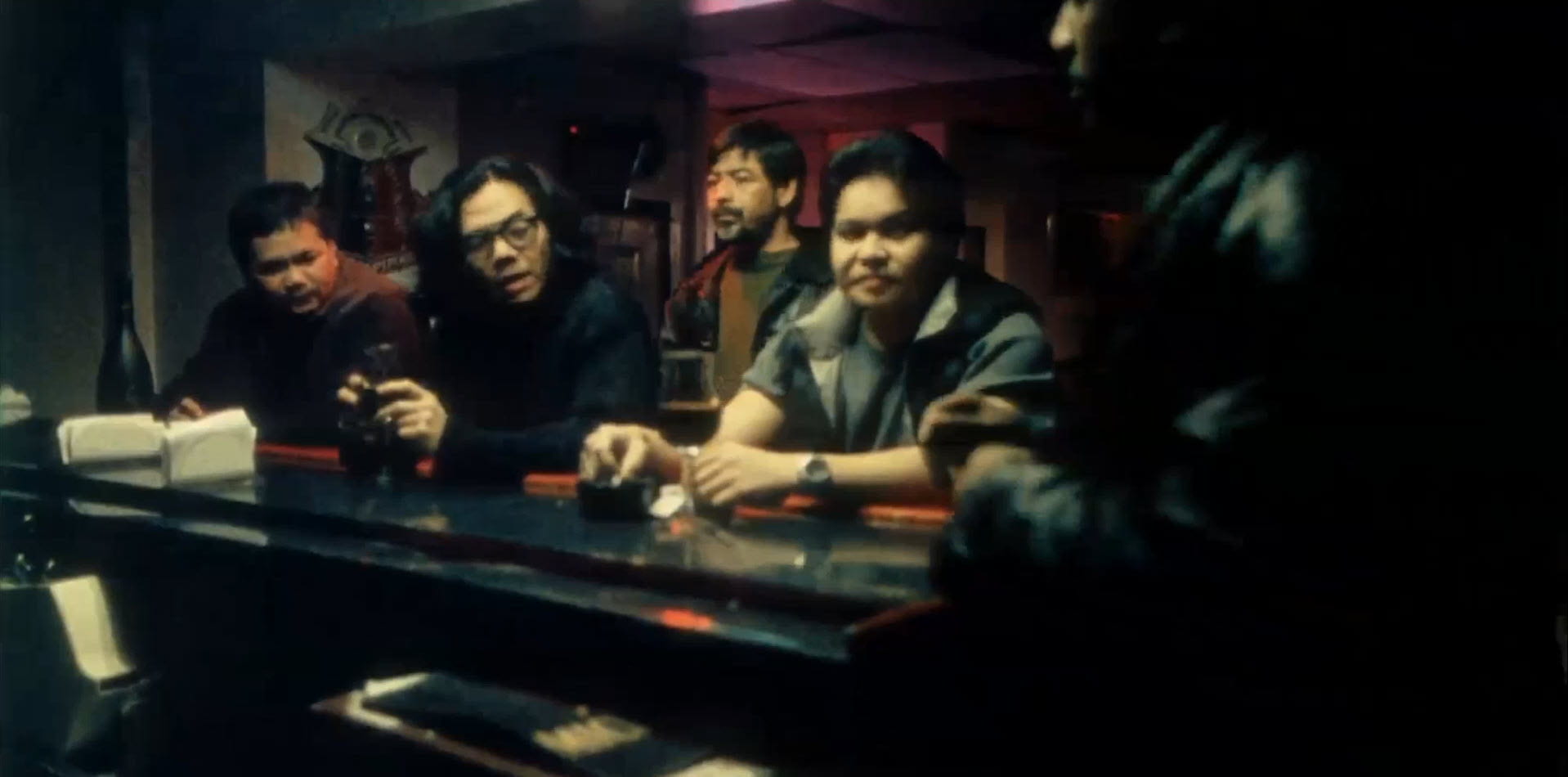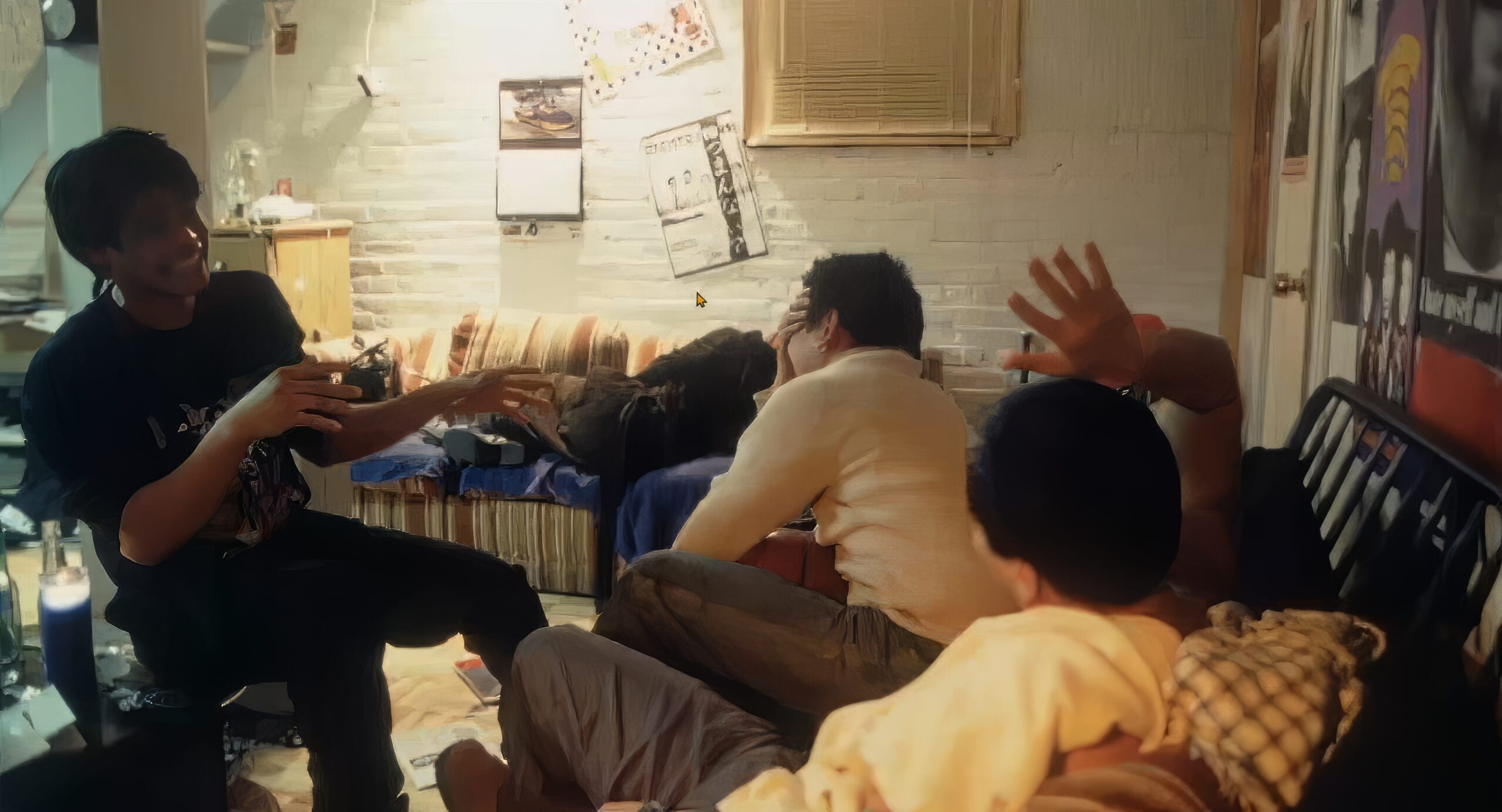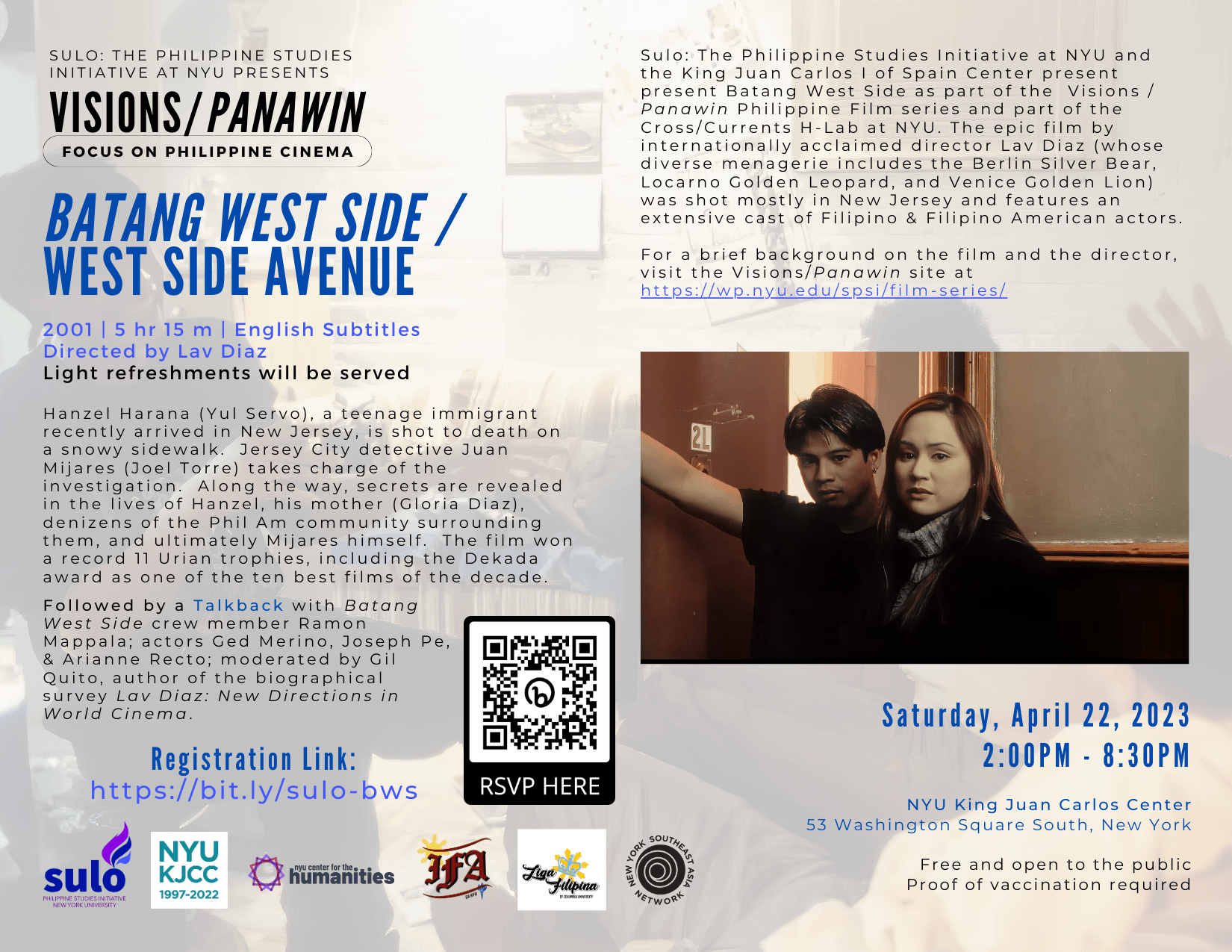2001 | English subtitles | 5 hr 15 m | Written and Directed by Lav Diaz
Followed by a Talkback with Batang West Side actors Ged Merino, Joseph Pe, and Arianne Recto; crew member Ramon Mappala; moderated by Gil Quito, author of the biographical survey Lav Diaz: New Directions in World Cinema.
Date: Saturday, April 22, 2023 | 2:00 pm – 8:30 pm
Venue: NYU King Juan Carlos Center | 53 Washington Sq S, NYC 10012
Open to the public; proof of vaccination required. Light refreshments provided.
RSVP link: https://bit.ly/sulo-bws


Synopsis
Hanzel Harana (Yul Servo), a teenage immigrant who recently arrived in New Jersey, is shot to death on a snowy sidewalk. Jersey City detective Juan Mijares (Joel Torre) takes charge of the investigation. Along the way, secrets are revealed in the lives of Hanzel, his mother (Gloria Diaz), denizens of the Filipino American community surrounding them, and ultimately Mijares himself. The film won a record 11 Urian trophies, including the Dekada award as one of the ten best films of the decade.
Notes on the Film Excerpted and adapted from Lav Diaz: New Directions in World Cinema (written by Gil Quito, Panawin curator) published in the book Direk: Essays on Filipino Filmmakers (Manila/Portland, OR/Eastbourne, UK, 2018)
After directing some ultra-low-budget films in the Philippines for Regal productions, Diaz wanted to shoot his 1996 Palanca-winning screenplay West Side Avenue, JC, set in New Jersey. However, no interest from the studios was forthcoming. Eventually, Diaz met Tony Veloria, a wealthy accountant at a top Makati firm, then looking for a project for his handsome protégé Yul Servo, who was dreaming of becoming an actor. Diaz gave Veloria a copy of the script and before a week was over, Veloria handed Diaz a check optioning the project.
However, uncertainty soon plagued the enterprise. With Veloria having joined the project primarily to jumpstart Servo’s career, an unstable relationship between him and Servo resulted in an unpredictable start-stop pattern in the funding coming from Manila. Even after the leads Servo and Joel Torre and production designer Cesar Hernando had flown to New York, the funding torments persisted. Weeks of sporadic shooting and waiting for funds that stretched the production period to a ramshackle eight months caused a number of major cast members to drop out during this period. Former Miss Universe turned popular sex-comedy actress Gloria Diaz eventually got the female lead role as a desperate last-minute substitute.
There came a point when Diaz had to use his own savings to buy film stock just to keep things going, and all this expense on a project that was then uncertain of even getting completed. The experience made Diaz’s wife demand that he stop making films and it eventually wrecked their marriage: “It was crazy because I used a lot of our savings for the shoot when we had little of it. And during pre-production, a lot of people were staying in my house in New York. She saw the chaos and maybe the futility of what we were doing. That was one year of chaos. I can understand the condition she was in then. But I have to preserve my self-respect. I am an artist. How am I going to leave cinema? I do respect her decision.”
Under the chaotic conditions, it helped that Diaz had cast the actor Joel Torre as one of the two leads. Torre is famously patient and accommodating, even more so for an actor of his achievement and renown. Having none of the movie star mentality, he would sleep anywhere, on the couch or the floor if there were no other spot available. The same could be said of the neophyte Servo.
Help from Diaz’s local Phil Am friends were vital in keeping together a venture that was always threatening to implode, and he cast some of them in huge crucial roles, including Ged Merino, Arianne Recto, Joseph Pe, Jomari Roldan, and Michele and Luis Salvador (children of Lino Brocka protégé Philip Salvador).
Diaz somehow managed to take advantage of the delays and uncertainties to evolve the story from its original 100-page length into what would become Batang West Side/West Side Avenue. Diaz says: “I initially wrote a story that deals with the struggle and guilt of a mother and the death of her son whom she brought to America. Then it grew and grew until I made it into a diaspora of Filipinos living abroad – the struggle of our countrymen detached from their homeland while at the same time using as a backdrop the Filipino struggle as a whole.”
After the film was finished, conflict with the film’s producer erupted when Diaz refused to cut the film to three hours in order to make it commercially viable. Servo by then had broken away from his relationship with Veloria who went into despair. With the film showcasing Servo in his acting glory, Veloria swore that the film would never be seen in public again. There were rumors that Veloria had destroyed the negative and prints. For years, Batang West Side became one of the legendary unseen works of Philippine cinema. There was a DVD version that was available but the transfer was so bad that watching it made one throw up hands in nausea after a few minutes, so that there really was no way of seeing the film and it was feared lost. (Such a situation is not unknown in Philippine cinema. A jealous producer of one of the films of director Mario O’Hara threw the negatives into the Pasig River.)
As it turned out, the negatives of Batang West Side survived just by a hair’s breadth. The film director Mike de Leon had by then retired from making films and was continuing to manage the family’s film production and processing facilities, LVN. One day, he happened to spot some cans of film in the garage. He asked what they were doing there and one of the workers said that they were about to be thrown away as the producer had ordered. De Leon went over to the cans and saw “Batang West Side” written on them. They were the film’s negative. He took the cans home and kept them there for three months before passing them to Alexis Tioseco, film critic and Diaz advocate. Tioseco then arranged for the heavy five-hours worth of film to be secretly shipped out of the country and deposited at the Austrian Film Museum in Vienna. Without that chance intervention, Batang West Side would have become another of those much-lamented films, legendary but lost forever, like Gerry de Leon’s Daigdig ng mga Api/World of the Oppressed or Lino Brocka’s Ang Mananayaw/The Dancer.
Batang West Side was a major turning point in Diaz’s evolution as an artist. Previously, his films hewed to the conventional limit of 2 hours. It was while taking flight with Batang West Side that he allowed the subject to organically dictate the running time, to breathe fully, to explore byways where epiphanies could burst forth. He would afterwards be known for the length of his films, sometimes as long as 11 hours (Evolution of a Filipino Family), several of them 9 hours. But running time, in the end, is the least of the distinctions of his films. More compelling are the visionary ways they grapple with the arduous history and struggles of Filipinos, the fractures caused by colonialism and dictatorships, and the universal themes of guilt, redemption, evil, and transcendence.
A sustained feat of quiet tension and poetic vision, Batang West Side, in its running time of over five hours, feels a lot shorter than most two-hour features, much like the 5 1/2-hour Carlos by Olivier Assayas. Restored by the Austrian Film Museum where it had secretly taken haven for many years, the film remains one of the most riveting and compelling films of the Philippine film canon.
Notes about the Writer / Director
Lavrante Indico Diaz grew up in a remote hamlet without electricity in the southern island of Mindanao, where his parents had volunteered as teachers for inhabitants who still had to be taught how to use soap and brush their teeth and that they lived in a country called the Philippines.
Diaz’s parents were passionate about Russian literature, especially Dostoyevsky who would become a major influence in Diaz’s artistic development. The father was also an incorrigible cinephile and on the weekends, he would take Diaz and his siblings on the long and bumpy journey to a town with four theaters where they would, over two days, watch all the double bills (mostly Filipino melodramas, fantasies, comedies, and actions films with the occasional stray curiosity like Herzog’s Aguirre, the Wrath of God) and where they would sleep overnight in the mosquito-infested bus station to save money.
After taking a course in Economics, Diaz started working as a member of a rock band that he eventually had to give up due to starvation earnings. At about this time, he saw Lino Brocka’s Manila: In the Claws of Light. Of the experience, he said: “It changed my perspective on cinema. It led me to filmmaking. It made me realize that film is not merely entertainment. Cinema could also be a potent tool for discourse.”
To support a growing family, he worked as a book salesman, comics writer, sports magazine proofreader, teleplay writer, and tabloid reporter among a motley of jobs. After apprenticing as a documentary writer with the elderly great director Lamberto Avellana, he worked for a while as a screenplay writer for the box office “action king” Fernando Poe, Jr., before resigning due to his inability to continue hack writing for purely commercial ends.
He wrote and directed his first short films after being accepted for a workshop by the Mowelfund. One of his shorts got invited to join a touring program, which brought him to New York. Here, he worked as a gasoline attendant and reviewer of Filipino films on VHS for a local Phil Am periodical. He went back to the Philippines to write and direct some insomnia-inducing low-budget “pito-pito” films (“seven-seven,” referring to the strict regimen of seven days of shooting, and seven days post-production) for Regal Films. Nevertheless, he managed to infuse films of this period with the social and metaphysical themes that would continue to illumine his later films.
The tortuous experience of creating Batang West Side liberated Diaz’s creativity in almost explosive ways. His following works would include Melancholia (Venice Orizzonti Best Film), Norte: The End of History (Cannes Un Certain Regard Official Selection), From What Is Before (Locarno Golden Leopard), Lullaby to the Sorrowful Mysteries (Silver Bear at Berlin where Jury President Meryl Streep said: “This man: He changed the molecules of my brain.”), Genus Pan (Venice Orizzonti Best Director) and The Woman Who Left (Venice Golden Lion for Best Film).
Major Lav Diaz retrospectives have been held in several cities, including New York (Film Society of Lincoln Center), Brisbane (Australian Cinematheque), Seoul (Korean Film Archive), and Paris (Jeu de Paume).
Diaz is the recipient of the Guggenheim Fellowship, the Prince Claus Award of the Netherlands, and Harvard University’s Radcliffe Fellowship. Diaz accepted the invitation for membership by The American Academy of Motion Pictures Arts and Sciences. He has received Lifetime Achievement awards from the Filipino Academy of Motion Picture Arts and Sciences and the Gawad Urian. The laurels have failed to lull Diaz into blissful repose. His continues to shuttle between homes in Queens, New York, and Marikina, Metromanila, and his output remains as prodigious as ever.
Two of Diaz’s most famous films, Norte: The End of History and The Woman Who Left, are available on DVD/Blu-ray at the NYU Library and the New York Public Library.
– Gil Quito, Curator
- Urian: Best Picture, Direction, Screenplay, Actor (Joel Torre), Supporting Actor (Raul Arellano), Supporting Actress (Gloria Diaz), Cinematography, Production Design, Music, Sound, Dekada Award
- Cinemanila International Film Festival: NETPAC Award, Best Actor (Joel Torre, Yul Servo, Arthur Acuña, Ruben Tizon)
- Singapore International Film Festival: Best Asian Feature Film
- Brussels Film du Independent: Best Picture, Best Actors (Joel Torre, Yul Servo)

Sponsors